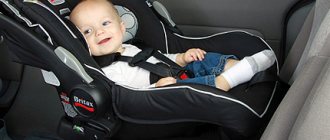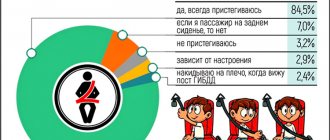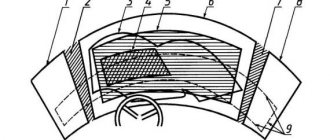Not every Russian car owner will be able to competently answer the question of what a seat belt pretensioner is and why it is needed. Some believe that this is the same inertial reel that holds the belt during a sharp maneuver or jerk, preventing the seated person from falling out of the chair. This is mistake. The pretensioner is part of the belt design, one of the purposes of which is to limit the force.
Have you ever needed the help of a car lawyer?
Not really
The history of belts
The massive distribution of seat belts occurred in the 50s of the last century. This was due to the fact that at ever increasing speeds, accidents began to lead to quite serious injuries and often deaths.
Gustav Lebe, a French scientist, proposed installing five-point seat belts on cars back in 1903. But at that time his idea did not meet with much enthusiasm, and as a result, did not take root. During the research for the best design, more than a dozen devices were invented, but none of them, for a number of reasons, took root. Some are due to the complexity of the design and fastenings, others due to insufficient reliability.
Take, for example, the same two-point seat belts. Fixing the passenger or driver at waist level, in the event of a collision, they did not save them from hitting the dashboard, steering wheel or windshield. After all, the upper body was not fixed at all. Some GAZelle car models still have a similar mount (front seat next to the driver).
The pioneer, whose invention not only caught on, but also became widespread, and later became the progenitor of all modern three-point seat belts, was Nils Bohlin. An engineer from Sweden, who worked on ejection safety systems for an airline, came to Volvo and proposed a three-point system.
Article on the topic: How does antifreeze differ from antifreeze, which is better and what is the difference
New developments
Developments to improve this security feature are ongoing. The latest innovation widely used on cars is pretensioners. But they are not the latest technology.
Tapes are already being developed that also act as pillows. The bottom line is that upon impact, it is filled with gas, due to which the area of contact of the body with the strap increases, which helps to better distribute the load and reduce injury.
They are also developing an electronic self-adaptive pretensioner system; depending on the use and stretching of the strap, it determines, according to given algorithms, the weight of the passenger and, accordingly, the required force to hold him at the time of the accident.
Three point static seat belt
The design of this design was simple. Diagonal and waist strap with a lock that was fixed at the hip. The fastening is the same as in a modern car, with the only difference being that the fixation system was static. A significant drawback of this system is the need for adjustment. Having sat down and buckled up, the passenger had to adjust the fastening so that no more than two fingers could fit under the strap. If the length was greater, safety was again at risk. In the event of a collision, the body managed to gain acceleration before it encountered an obstacle in the form of a seat belt.
And really, where from?
There is a hypothesis that the very first seat belt was made in 1885 in the USA. Edward Claghorn patented his design in the form of a belt for tourists who traveled in open carriages. But there is another version - it says that Adolf Pegu was the first to install the belts. A French airplane pilot came up with this design in order to be able to fly upside down for the longest time and set a world record. However, there is no end to these disputes.
For many years, seat belts were ignored by car consumers due to the categorical inconvenience of use. The belt simply constrained the actions of the person driving and was more likely to harm than protect in an accident. And no one wanted to install such devices for an additional fee.
Evolution of the belt
Inertial three-point seat belts, which replaced static ones in the 70s, were a breakthrough in the field of safety. They not only corrected the statistics of deaths and injuries in road accidents, but also almost doubled the number of people wearing seat belts. After all, there is no longer a need to adjust the belt when getting into the car. I sat down, buckled up, and the inertial reel itself took away the excess.
The design is such that in the event of an accident, the ball or pendulum mechanism of the reel fixes the tape and prevents it from unwinding, thereby securely holding the body. The inertial belt reel device blocks the belt when the car rolls over, in the event of a roll or skid, as well as during sudden braking. It would seem that three-point seat belts are ideal in terms of safety, but like any other, they have a significant drawback.
This is a delay in response, and in an accident, when the count is a fraction of a second, this delay can be dangerous. In winter, when a person is dressed in a large amount of clothing, the device creates that dangerous space between the belt and the body, as a result of which the body manages to gain serious speed. Therefore, the next stages in development were systems that operate proactively.
Article on the topic: Is it possible to dilute antifreeze with water: recommendations from experts
Types
According to the number of attachment points to the frame, seat belts are divided into two-, three-, ... and multi-point (usually six-point):
Point-to-point
Belt
Until recently used by many car manufacturers on rear passenger seats; also used on some buses. They are widely used on airplanes because, while holding the passenger in the seat, they nevertheless provide the opportunity to freely assume a pose for a safe landing.
Shoulder
Runs from hip to shoulder. They were used in cars of the 1960s, but were not very successful, since in an accident the passenger could easily slip out from under such a belt.
Three-point
Three-point seat belt
The three-point belt combines the shoulder and lap belts, but at the same time it is a single section of the belt along which the buckle moves, which makes it easy to fasten or unbuckle. In the event of an accident, the braking force is distributed over a large area of the chest, shoulders and hip girdle, which makes it much easier to bear the impact. The three-point belt was invented by Niels Bohlin, and was first used in the Volvo PV 544 production car in 1959.
Until the 1980s, three-point seat belts were primarily used only in the front seats of cars; the rear seats were equipped with either lap or shoulder seat belts. However, evidence that lap belts can cause vertebral misalignment and paralysis (“seat belt syndrome”) has led to a revision of safety regulations in almost all developed countries, and the requirement for three-point belts in all seats. As of September 1, 2007, all new vehicles sold in the United States are equipped with three-point seat belts.
In addition to changes in regulations, "seat belt syndrome" has led to a number of lawsuits. In particular, in Los Angeles, the trial ended with a jury verdict to fine Ford $45 million.
It is not recommended to fasten children and people with a small torso with three-point belts, since with the typical dimensions of the seat and the position of the attachment points, the upper segment of the belt will pass dangerously close to the throat of the person wearing it.
Three-point belts also come in two types: inertial and non-inertial.
Inertial
: these are exactly the belts that we are now accustomed to seeing on almost all more or less modern cars. When unfastened, the inertial belt is retracted by a special device, and thus is located along the wall of the passenger compartment. To fasten the inertia belt, you need to pull it out and secure it in the belt buckle. After unfastening, such a belt automatically returns to its place.
Non-inertial
: such belts are not automatically removed when unfastened, but remain on the seat. There is a significant difference in how to properly fasten with an inertial belt and a non-inertial one. If the inertial belt automatically adjusts its length and holds the person tightly on its own, then for a non-inertial belt it is necessary to first select the length of the strap. When fastened, the length should be such that your palm fits between the strap and the chest. Do not loosen the belt too much or tighten it too much, as this may cause injury.
There are also belts with pretensioner
. The pretensioner is activated during an accident: it regulates the force holding the person by the belt.
Multipoint
Multi-point racing car seat belts
They are used in the cockpits of airplanes and helicopters, racing cars, etc. In racing cars, five- and six-point seat belts serve, in addition to their main purpose, as an additional means of lateral support, holding the driver's body in the driver's seat. Currently, in certain series such as NASCAR, NHRA, USAC, eight-nine and even ten-point seat belts are often used. this is due to the special types of overloads common in these auto races.
In civil aviation aircraft, pilots usually wear four-point seat belts, while in military aircraft, pilots use five- and six-point seat belts. Spacecraft also use multi-point seat belts. In car child restraint devices (infant carriers and car seats), five-point belts are often used to fasten the child to the device.
Belt pretensioners
The first in this area were squibs, which, receiving a signal from the control system, when triggered, tightened the seat belt, the length decreased, reducing that same dangerous distance. To prevent the tension from being critically strong, the tensioner design contained a force limiter, a device that, when the load on the chest was exceeded (approximately 150 kg), began to give slack, thereby weakening the belt’s dead grip. The only drawback of these devices was and remains their disposability. After activation, the squib must be replaced.
The system of electric tensioners is completely free of this drawback. They are able to perform this action repeatedly. Working in conjunction with radars and sensors, they are able to determine critical proximity even before the moment of collision, which means protecting passengers and the driver in advance. If the device detects a danger, the length of the belt is shortened and the person is securely fixed in the chair.
What in the end...
It is important to decide for yourself that the use of a seat belt is not a condition of malicious traffic regulations, which are only allowed to burden unfortunate motorists. First of all, this is our own protection from possible damage that awaits us at every corner.
An airbag is not always able to protect us from injury, since the inertial force of an impact can displace the passenger's body away from the deployed airbag. The consequences of significant tugging on the body of a passenger or driver are negligible compared to the damage to an unbelted person.
Another common opinion is that some argue that it is not necessary to wear a seat belt while in the back row. Even despite the protective barrier in the form of a seat in front, an unrestrained rear passenger still has a high probability of flying through the windshield or receiving other life-threatening injuries.
Other types of belts
There are also four-point and five-point harnesses. These are sports seat belts and are used to securely secure racing drivers. The first has four fastening points, and the second, respectively, five. The five-point seat belt is also used in child car seats that have recently become mandatory. This mount most reliably fixes the body and distributes the load on it.
Another variety has appeared called inflatable seat belts that fill with gas during an accident. The fastening of such belts is mainly three-point.
What conclusion can be drawn from all of the above? Many minds are concerned about the safety of the driver and passengers, many people are working to improve safety systems designed to save our lives and health. It's up to you to decide whether you should neglect this, but when getting into the car, remember that everything possible has been done for your safety; all you need to do is buckle up.
Share with friends on social networks:
Telegram











